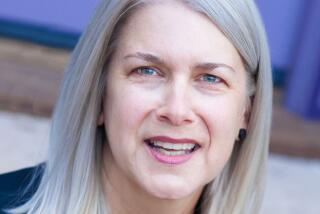Review: Love, Icelandically: On Oddny Eir’s novel ‘Land of Love and Ruins’
Oddný Eir has written novels, essay collections and books of poetry. She is also an environmental activist with a degree in political philosophy from the Sorbonne. Her novel “Land of Love and Ruins” was written in the aftermath of the Icelandic banking crisis (the canary in the coal mine for the 2008 global financial crisis) and won the EU Prize for Literature as well as the Icelandic Women’s Literature Prize. It is the first of her works to be published in English, unless you count the lyrics she’s composed for Bjork.
“It’s strange being home,” writes the novel’s narrator, a woman in her mid-30s visiting her family after the end of a long-term relationship. “I’m relieved, though I still feel a bit homesick. I’ve got to try to create a home of my own. Probably alone.” The novel — which its publisher describes as autobiographical, though not as memoir — takes the form of a diary or journal. In lieu of dates, the short chapters (or entries) are marked by feast days, holidays, moon phases, solstices. They are also tagged by location: Reykjavík, Skógar, Basel, Cumbria and elsewhere across the Icelandic countryside and throughout Europe. The unnamed narrator is occasionally accompanied by her brother or her new lover. Both men are only ever identified by their occupations — the archaeologist and the ornithologist, respectively — or else by her private nicknames for them: the lover is Birdie; the brother, Owlie.
Peripatetic and reflective, bookish and quietly beguiling, the narrator of “Land of Love and Ruins” has clear antecedents in the W.G. Sebald of “The Rings of Saturn” and Teju Cole’s Julius in “Open City.” If her solitude is less reticent, less chastened than theirs, this is likely because she has not been driven by oblique trauma to protective self-erasure. She seeks connection with others and is honest about her desires, even as she worries about the emotional and intellectual costs of compromising her autonomy in order to fulfill them. She notes that “being dependent on intimacy, closeness, is just a short step from depression.” In this way, “Land of Love and Ruins” is less an extension of Sebald’s line than of recent path-breaking, genre-porous narratives such as Eileen Myles’ “Inferno,” Jenny Offill’s “Dept. of Speculation,” Maggie Nelson’s “The Argonauts” and Lynne Tillman’s “Someday This Will Be Funny.”
For Eir, the personal and the political, the private and the public, have direct and immediate bearing on each other. This is an evergreen notion, of course, but one of special urgency in contemporary Iceland, an ecologically fragile country falling victim to its own success as a tourist destination, a place where the gene pool is so small there’s an app for singles to find out whether they’re too closely related to sleep together. As it happens, incest is a running theme in “Land of Love and Ruins.” Neither endorsed nor denounced, it is simply … interesting to the narrator, perhaps as an expression of love that simultaneously perverts and venerates the nuclear-familial norm. She considers a number of brother-sister pairings throughout history: the Egyptian gods Osiris and Isis were married and had a son; William and Dorothy Wordsworth were, so far as we know, platonic, though their relationship was for all intents and purposes a marriage; “[a] certain Guðrún from Jökulsárhlið” was banished from society for bearing her brother’s child, so she fled to the mountains, he joined her, and “they lived in peace and harmony for many years, far from human habitations and in defiance of the law.”
Only an Icelander could be this candid and nonchalant about such a taboo subject. A Frenchman tackling the same material would produce giddily cynical pornography; an American po-faced pedagogic tragedy. But if Eir’s unassuming cool is a cultural trait, it serves her particular agenda, a call for radical interrogation of the so-called “normal” at all points on the social-cultural spectrum. Questions about what makes a family, what constitutes a partnership, and how the need to love and be loved conflicts with the need to be your own person, become questions about what makes a country, what constitutes sustainability, and what happens when growth and consumption exceed the limits of what the earth can bear. “Private ownership of vast tracts of land appears to be an anachronism,” she writes at one point, in a deadpan I can only describe as enviable. “Finally, water is being legally classified as a resource. But what about the desolation, the beauty and the spiritual space, the atmosphere?” “Land of Love and Ruins” is an extraordinary novel. I can’t remember the last time I read a book at once so understated yet unrestrained.
Taylor’s most recent book is the story collection “Flings.”
By Oddný Eir
Restless Books: 240 pp., $16.99 paper
More to Read
Sign up for our Book Club newsletter
Get the latest news, events and more from the Los Angeles Times Book Club, and help us get L.A. reading and talking.
You may occasionally receive promotional content from the Los Angeles Times.






